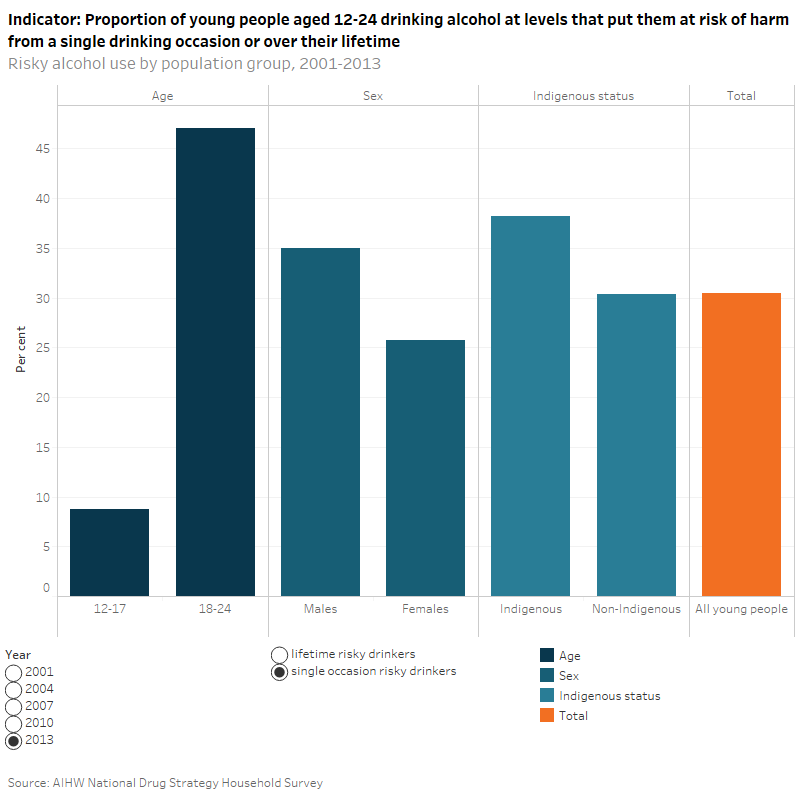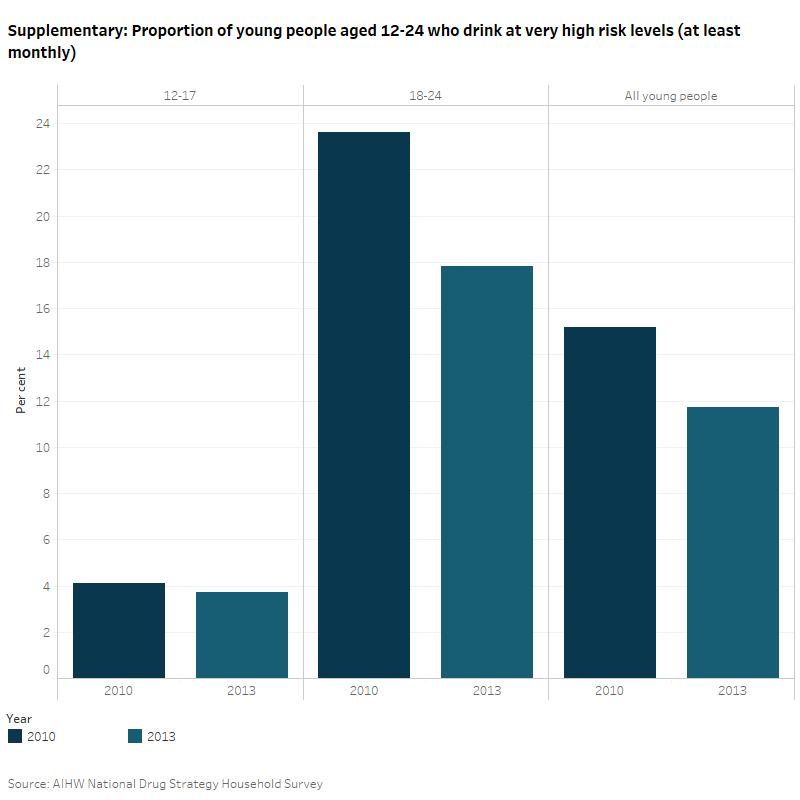Alcohol use
Why is reporting on alcohol use important?
Drinking alcohol can be harmful to young people’s development and it can have ill effects on health and wellbeing. Alcohol-related damage to the brain has been associated with learning difficulties, alcohol dependence and depression (MCDS 2011). Long-term excessive use of alcohol can lead to a number of physical, emotional and social problems.
In 2009, the National Health and Medical Research Council (NHMRC) released new Australian guidelines to reduce health risks from drinking alcohol. For healthy men and women, drinking no more than 4 standard drinks on a single occasion (single-occasion risky drinkers) reduces the risk of alcohol-related injury arising from that occasion. Drinking no more than 2 standard drinks on any day reduces the lifetime risk of harm from alcohol-related disease or injury (lifetime risky drinkers). For young people under the age of 18, not drinking at all is the safest option (NHMRC 2009).
Various strategies and initiatives have been implemented which aim to raise awareness of the detrimental effects of risky drinking among young people, and which will contribute to developing a more responsible drinking culture among young Australians (DoH 2013).
Do rates vary across population groups?
In 2013, 31% of young people aged 12–24 drank alcohol at levels that put them at risk of harm on that occasion. The proportion 18–24 year old single-occasion risky drinkers was more than five times that for 12–17 year olds (47% compared to 8.7%) and greater among males than females (35% compared to 26%). There was no statistically significant difference between the proportion of Indigenous (38%) and non-Indigenous (30%) single-occasion risky drinkers.
Around 13% of young people drank at levels that put them at risk of harm over their lifetime (lifetime risky drinkers); this was significantly lower than the proportion of all young people who drank at risky levels on single occasions (31%). Young people aged 12–17 were less likely to engage in lifetime risky drinking than 18–24 year olds (2.6% compared to 21%). Males were more likely to be lifetime risky drinkers than females (17% compared to 9%). There was no statistically significant difference between the proportion of Indigenous and non-Indigenous life-time risky drinkers (*11% and 14% respectively).
Has there been a change over time?
There was a significant decline in single-occasion risky drinking among all young people from 47% in 2001 to 31% in 2013. There were similar declines among 18–24 year olds (from 57% to 47%), males (52% to 35%), females (41% to 26%), and non-Indigenous young people (46% to 30%). There was also a significant decline in single occasion risky drinking among 12–17 year olds from 17% in 2004 to 8.7% in 2013.
There was no clear trend or significant difference among Indigenous young people over this period, with proportions fluctuating between years.
From 2001 to 2013, there was a clear decline in the proportion of all young people drinking at lifetime risky levels, from 24% to 13%. There were significant declines in lifetime risky drinking among males (30% to 17%) and non-Indigenous young people (24% to 14%). For 12-17 year olds, there were also significant reductions in lifetime risky drinking between 2004 and 2014 (from 6.4% to 2.6%). There was no clear trend between 2001 and 2013 for 18–24 year olds, females and Indigenous youths.
From 2010 to 2013, there was a significant decrease in the proportion of all young people drinking at very high risk levels (more than 10 standard drinks on a single occasion) at least once a month (from 15% to 12%). This appears to have been largely driven by reductions in very high risk drinking among 18–24 year olds (from 24% to 18%).
Between 2001 and 2013, there was a significant increase in the proportion of young people who abstained from drinking (increasing from 20% to 41%). This increase was evident among 18–24 year olds over the same period (increasing significantly from 11% to 17%). There were also significantly higher proportions of 12–17 year olds who abstained from drinking between 2004 and 2013 (increasing from 54% to 72%).


This report is based on survey data; relative standard errors and 95% confidence intervals are provided in the Source data tables: NYIF indicators. Some estimates have relative standard errors of 25% to 50% and should be used with caution. Estimates with relative standard errors greater than 50% have been suppressed. Significance testing was undertaken on values cited in the text; unless otherwise stated, differences were found to be statistically significant.
In 2001, the National Drug Strategy Household Survey did not include 12–13 year olds; consequently, the 2001 total is for people aged 14–24.
Single occasion risky drinking refers to having more than four standard drinks, at least once a month.
Lifetime risky drinking refers to having an average of more than two standard drinks per day.
Abstainers refer to young people who had not consumed alcohol in the previous 12 months.
Young people at very high risk of alcohol related harm are those who consume more than ten standard drinks on a single occasion at least yearly or monthly (at least yearly and at least monthly are not mutually exclusive).
AIHW National Drug Strategy Household Survey
Data quality statement: AIHW METeOR
Department of Health 2013. National Binge Drinking Strategy.
Ministerial Council on Drug Strategy 2011. The National Drug Strategy 2010-2015. Canberra: Commonwealth of Australia.
NHMRC 2009. Australian guidelines to reduce health risks from drinking alcohol. Canberra: NHMRC


